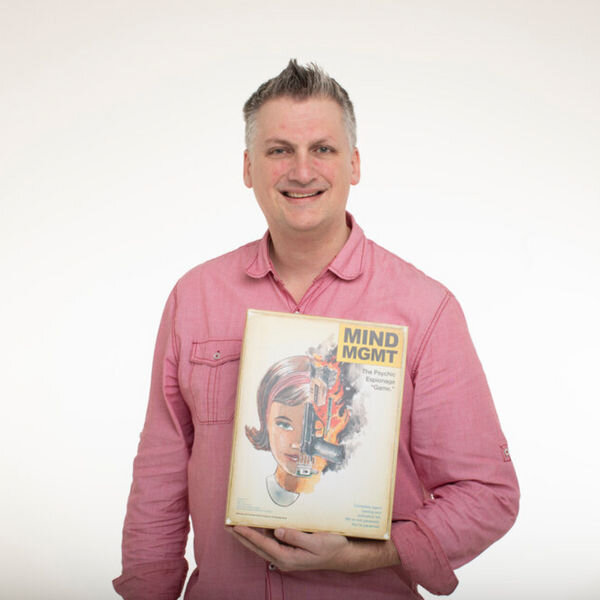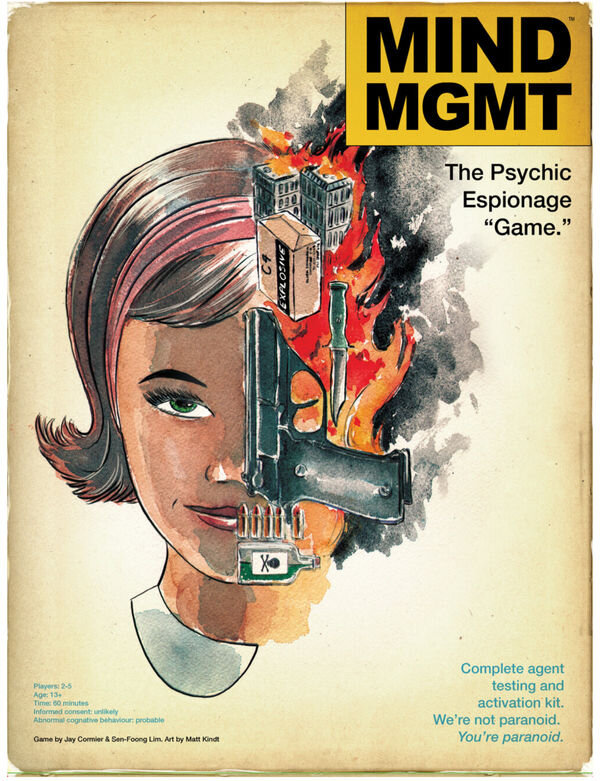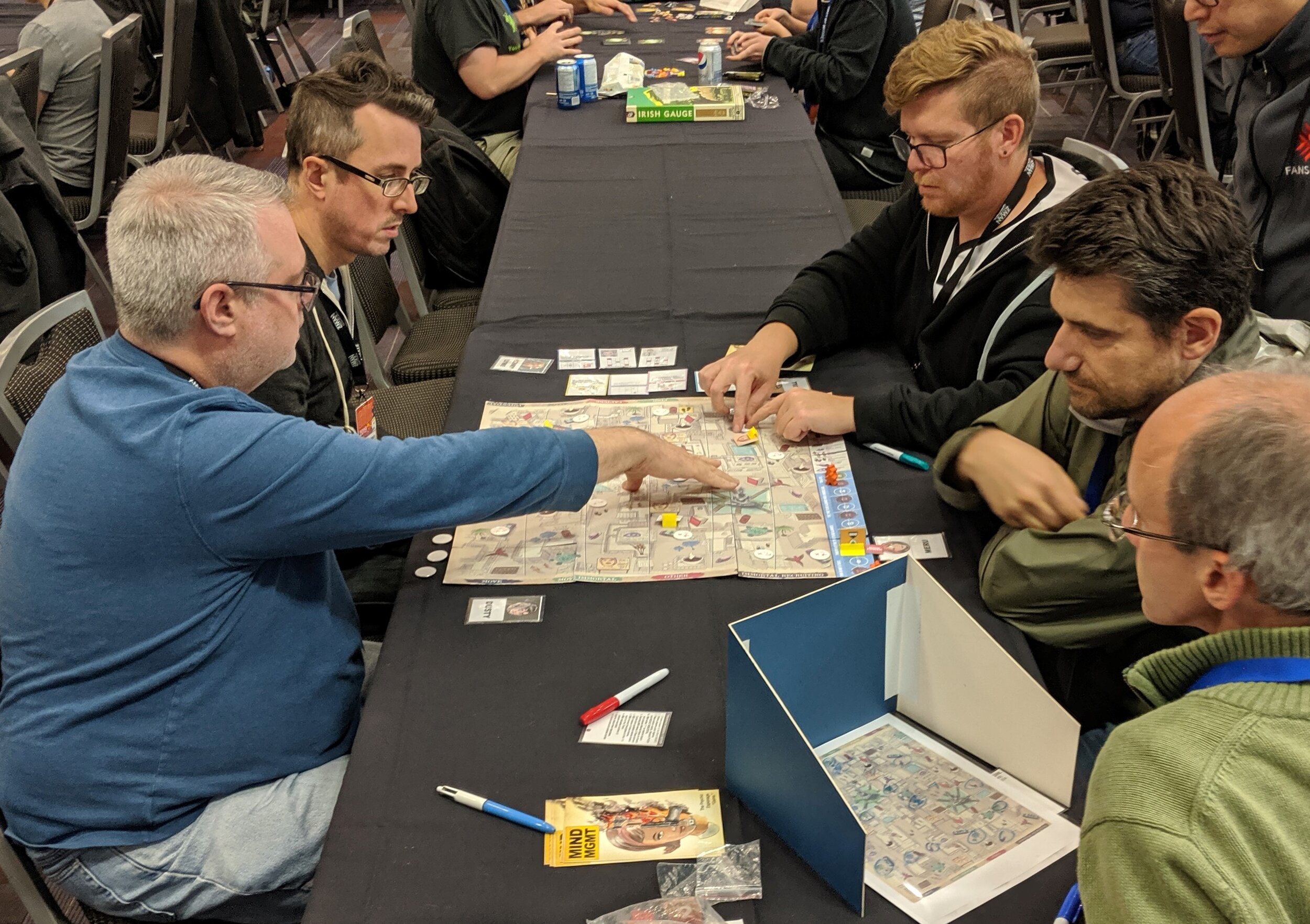-Tell us about yourself – Who are you? What do you do?
Hello! I’m Jay Cormier, a man of many hats! How many hats? Let’s see:
Hat #1: I’m probably best known as a game designer, with numerous games published that some of you might have heard of: Belfort, Akrotiri, Junk Art, D&D: Rock Paper Wizard and many more!
Hat #2: In the game designer world I might be known as the creator of the Fail Faster Playtesting Journal. I created a journal to help designers take notes they need to take in order to become better playtesters!
Hat #3: I might start getting known as a publisher as I just started my own publishing company called Off the Page Games, with our first game, MIND MGMT: The Psychic Espionage “Game” currently on Kickstarter (and doing extremely well, I might add!)
Hat #4: I am known in Vancouver amongst video game design students as an instructor. I teach board game design as part of the Vancouver Film School’s video game design program.
Hat #5: I am known in the corporate training world as someone who brings gamification to events. I have gamified multi-million dollar training events as well as created escape room games that can scale up to hundreds of people for multiple corporate training companies.
Hat #6: Around my house I am known as daddy to two 3-year old twin boys!
-I interviewed you as part of Bamboozle Brothers team back in 2015 – what big changes have you made with your game designing since then?
The biggest change is the fact that I’m always trying to change. I don’t like visiting the same well more than once and I love to design games that offer me new challenges. If you look at the games I’ve designed, you can see that there’s no pattern, except for the fact that I’m trying to design as many different types of games as possible. I just had a game that I designed solo get published called Draw Your Own Conclusions. It’s the first drawing game that I’ve had published. Before that I had In the Hall of the Mountain King, which is my first polyomino game (as well as a new mechanic called cascading production). Up next, Sen-Foong Lim and I have our first escape-room-in-a-box game coming out called Scooby-Doo Escape from the Haunted Mansion!
-One fact that we probably don’t know about you:
I was a children’s entertainer for over 20 years! My character’s name was Bertolt and I wasn’t really a clown — more of a storyteller that used magic to tell stories. I performed all across Canada and a bit in the US as well. I performed mostly for corporate gigs, but also did a few years of buskerfests too!
-What games are you playing most right now?
Whatever the next prototype of mine is in the queue! With twin 3-year olds at home, by board game playing time has dwindled for now, but I still have to maintain my playtesting schedule as you can’t design board games without playtesting. Recently I’ve been playtesting a game that’s been signed called Draw the Line (another drawing game – but this one is less a drawing game and more a communication game), and we’re testing a few different ways to give clues.
-What are your all-time favorite games?
I love Dominion, though I haven’t played in awhile. It ushered in the deck building genre and did it very well. I love Amerigo — my favourite Feld game as it has the most theme to it! I love the cube tower as it’s a clever way to randomize actions but keeping it fair from player to player. I will always play Time’s Up: Title Recall at a party as it’s always guaranteed hilarious for everyone. And I’ll never turn down a game of Tichu — the best partner card game of all time!
-What first drew you to making games? Has that driving force changed over time?
I have a background as being a performer and I think for me, the motivations are similar. As a performer I always wanted to make people laugh,and provide them some entertainment. As a game designer, I also want to provide people with entertainment. I find so much satisfaction when people tell me that they’ve played one of my games and that it brought them some joy. Isn’t that a great objective in life? Make things that create more joy in the world?!
-How has your game making process evolved since you first started making games?
It has for sure. I now spend less time than ever making the first prototype so that I can get it to the table as quickly as possible. Early on Sen and I would spend way too much time getting everything balanced before making that first prototype, only to learn that we had no idea where the fun was in the game. Now, we make a minimum viable product to test one aspect of the game to see if there’s something fun in it or not!
Also, with all my experience, a lot of things become easier as we can make decisions a bit faster, and we can foresee certain obstacles a bit sooner. This is one of the reasons why I always like designing games in new genres because there’s more challenge in that.
-What part of making a game do you most enjoy? What part would you rather delegate to someone else?
I love playtesting and going home and tweaking the prototype because I know what needs to change to improve the game. Sometimes when people have a ‘bad’ playtest, they go home feeling defeated, but not me. While I would love for a game to knock it out of the park, I love it when the game gets amazing feedback from my playtesters because then it means my game will end up being even better that I thought it would be.
I would love to delegate rules writing to someone else. It is a hard skill to have! On top of trying to communicate very clearly and concisely, it also takes a lot of effort to add all the images for each example!
-How do you market your games?
Up until now I haven’t had to as I was ‘just’ the designer, so the publisher had to do all that! Now that I’m a publisher with my first game on Kickstarter, I’ve had to figure this all out. It seems like a simple question but this answer could go on for a long time!
First, I started by being a somewhat known designer amongst some people. Me running a Kickstarter for a game now is totally different than if I ran a Kickstarter 10 years ago (if Kickstarter existed back then!). Then I ran a Kickstarter for the Fail Faster Playtesting Journal. How is that related? Well it gave me experience in running a Kickstarter and a reputation for running a smooth campaign with some fun engagement. Then I started my actual publishing company 9 months ago. I detailed my progress on a weekly YouTube show called How to Start a Board Game Company. While this niche is small, I got a decent following of people that were in a similar boat that were following what I was doing. The game that I am publishing is based on my favourite comic book for the last 20 years, so that already has some built-in fans. We leveraged the creator, Matt Kindt’s fanbase on social media as well as mine and Sen-Foong Lim. I would post new art as I got it, share it on some big Facebook groups and ask a bunch of questions on the publisher Facebook groups. Participating online goes a long way to people knowing who you are. Then early this year I subscribed to Gleam and ran some contests. I ran 4 contests, week after week where the winners would receive one of the games that Sen and I previously designed. Then I ran a month long contest where the winner would get a deluxe copy of MIND MGMT once published. I helped push those out using Facebook ads.
I got 15 sample copies of MIND MGMT made and sent them out to the reviewers that I thought would get me the most bang for my buck – and each of those cost money, of course. Then I bought some ad space on Boardgamegeek and finally I partnered with Jellop to help market my game while it’s on Kickstarter. Whew!
-What game-related or game business-related media do you consume on a regular basis?
I visit Boardgamegeek more than once a day. Other than that, nothing on a regular basis. I see all the big reviewers when they’re talking about a game I’m interested in! I’m not much of a podcast listener either.
-What are some tools/programs/supplies that you wouldn’t work without?
Computer, Printer, Cardstock, cubes, paper cutter, sleeves, Corel Draw. I can make almost any prototype with that! Some games require some specific components for sure (Junk Art!??), but those are the key supplies I need!
-I know you emphasize play testing, even making a play testing journal at Fail Faster – how do you find play testers?
I’m lucky because I belong to the Game Artisans of Canada. We have chapters all across Canada and one in Vancouver. We meet up every week and playtest each other’s games. We even have people show up that aren’t designers, but like playtesting games! I also love the feedback that comes from other designers too. Often they can see some problems that non-designers can’t see. Other than that, when I moved to a new city, it was really just going to game nights at my local game store. I met a lot of people that way that ended up becoming regular playtesters for me!
Playing Mind MGMT
-In our previous interview, you talked about proactively preventing as many work obstacles as possible by focusing on motivation, versatility, and persistence – are those still guiding considerations? What habit(s) do you find most useful for keeping your work on track?
Ah yes, MVP! For sure those are still my key to success. Fortunately, it’s easier to stay motivated right now because I always have 5-8 irons in the fire at any one time. When something is less interesting, I work on something else! I’m also partnering with other people and have 1 published and 1 signed game with 2 totally different designers not named Sen! In the Hall of the Mountain King was co-designed by Graeme Jahns and Draw the Line was co-designed by Chase Disher. Working with new people brings a lot of motivation into it as well. I talked about my desire for versatility, and persistence is still needed, even if you have a bit of a name in the industry. It’s easier to get into some meeting now though! But I still have some games that I am waiting to hear back from publishers!
-How do you handle life/family/work balance?
I am fortunate because my work allowed me to go down to part time. So I work 3 days a week at ‘work’ and then 2 days at home, working on my board game life! The ultimate goal is to quit my day job and work on board games full time! Weekends are mostly family time so I think everything is fairly well balanced!
-Who would you like to see answer these questions?
I’d love to know more about Phil Walker-Harding’s process and behind the curtain stuff!!
-What question did I miss that I should have asked?
What do you have coming up next?!
Oooh, I’m glad you asked!
With Sen-Foong Lim we have Scooby-Doo Escape from the Haunted Mansion (an escape room in a box type game), plus the reprint of Belfort (and a new expansion) is due out soon
With Sen and Josh Cappel we have WWE: Headlock Paper Scissors (uses the same system as the D&D Rock Paper Wizard, but it’s a whole new game)
With Sen and Ed Bryan we have a 2-player Godzilla card game
With Chase Disher we have Draw the Line, a communication game that involves a bit of drawing
In addition to all that, Graeme and I are working on a card game AND an expansion for In the Hall of the Mountain King. Sen and I are working on our next escape room in a box game. Shad Miller and I are working on 3 projects, one of which was signed, but the publisher has disappeared. Lots going on! 🙂
Thank you so much for your insight, Jay! You can find his complete profile on Board Game Geek or follow him on YouTube, Twitter and Facebook!
If you’re interested in how video games are made as well, check out our designer interviews at Doubtful Games!



